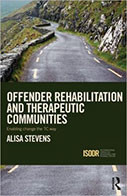Offender Rehabilitation And Therapeutic Communities:
Enabling Change The Tc Way

Author: Alisa Stevens
Publisher: Abingdon, UK; New York: Routledge, 2013. 240p.
Reviewer: Anne Worrall | May 2013
When I was training to be a social worker/ probation officer in the early 1970s, therapeutic communities were exciting innovations in the UK. Maxwell Jones, credited with founding the democratic style of TC (p.14-15), was something of an icon and we all wanted to do student placements in TCs. I was one of the fortunate ones who spent a few weeks in a small TC for young people with mental health problems, run by a religious charity. It was a harrowing experience and I quickly realised that being part of a TC was extremely hard work for everyone involved. There was no privacy – physical, social or emotional – for staff or residents. Problems were dealt with not in the reassuring safety of one-to-one counselling sessions but in a variety of different groupings, in what Stevens calls ‘real time’ (p.2)and we called ‘the here and now’ in those days. Several years later, as an experienced and more confident probation officer, I negotiated a short secondment to another TC – this time the famous Grendon Underwood Prison. I coped rather better that time but was still very aware of the total exposure experienced by anyone with sufficient courage to live in such a community for any length of time. I am not at all surprised that there is an attrition rate of up to 39% (p.71). Nor am I surprised that Stevens found carrying out ethnographic research in three TCs (two male and one female) to be so personally challenging, as she recounts in Chapter 2 of Offender Rehabilitation and Therapeutic Communities.
When I was at Grendon, the majority of its residents had been convicted of property and physical violence offences (p.20). Now the majority are serious sex offenders which makes for a very different dynamic. Evidence of the effectiveness of TCs purely in terms of reconviction rates is hard to come by, although some studies indicate that older, serious offenders who remain in TCs for at least 18 months may have significantly reduced rates of reconviction. Evidence that TCs produce significant improvements in the social and psychological functioning of residents is more robust, though still open to criticism from those wedded to the ‘gold standard’ of randomized controlled trials, which are near-impossible to implement in TCs (p.30).
Attitudes towards TCs within the criminal justice system in England and Wales are ambivalent, and less than one per cent of the prison population is accommodated in such units (Grendon being the only prison that is entirely a TC) (p.5). On the other hand, it is in many ways surprising that they exist at all, caught as they are between the popular punitiveness of penal policy and the professional hubris of ‘what works’ cognitive behavioural treatment over the past two decades. So what does a TC provide that is different? Stevens explains:
‘A therapeutic community… uses the social milieu and various forms of psychotherapy to help troubled people recognize and re-experience, in real time and within the real-life laboratory of a stable social community, the aspects of their personality and ways of thinking and behaving that have damaged them and…led to the infliction of damage on others’ (p.2).
Prisoners who volunteer to participate in a TC do so for a variety of reasons. Stevens identifies four typologies: the enthusiasts, who have discovered this approach through their own research and initiative; the followers, who have been recommended by others to participate; the desperados, who recognise that this is probably their last chance to make anything of themselves; and the escapees, who think the TC may be a soft option but are quickly disabused. All newcomers seem to be impressed by the welcome and respect they receive – so unlike system prisons.
Drawing on detailed interviews with 60 TC residents and 20 staff, Stevens characterises their experiences as a combination of, on the one hand, care, trust and support and, on the other, responsibility, accountability and safety. Unsurprisingly, residents who had previously been located in mainstream prisons, found it hard to believe that staff and fellow residents cared about them, could be trusted and were capable of offering genuine support. The extent to which residents praised the caring attitudes of staff was in marked contrast to their views about officers in other prisons. But it was no easier for staff. They were very aware that they ‘enjoyed’ (not an inappropriate term) ‘a stigmatized reputation among their peers’ (p.82).
However, the experience of feeling cared about, trusted and supported came at the cost of being required to expose oneself to a relentless regime of community meetings, during which one was held responsible for one’s every action and accountable to the whole community. It is at this point that the discourses of TCs come closest to ‘the neo-liberal discourse of personal responsibility [that] pervades contemporary penal governance’ (p.98). However, as many penal critics have pointed out, it is impossible to make prisoners genuinely responsible and accountable within the wholly constrained environment of the vast majority of system prisons. TCs provide an environment in which the safety of the community becomes everyone’s personal responsibility and residents are both required and enabled to hold each other and themselves to account for their behaviour both inside and outside the prison walls.
Overlaying these twin principles of care and accountability is a process of challenging the culture of hypermasculinity that characterises the expectations (of self and others) of male prisoners in the mainstream system. In the TC, men are allowed and expected to express and tolerate emotions other than those culturally associated with masculinity – aggression, hardness, invulnerability, competitiveness, sexism and the suppression of feelings of pain and affection. The ‘deflationary’ culture (p.130) of the TC enables male residents to admit to their own ‘softer’ emotions and to ‘de-other’ those who do not fit the stereotype of ‘real men’. It is this ‘de-othering’ that enables the integration of sex offenders into the TC community. Nevertheless, Stevens points out that there are limits to this process and that residual ‘othering’ remains, especially in relation to paedophiles.
Stevens’ main thesis is that the ‘TC way’ of rehabilitation, though pre-dating the concept of ‘desistance’ by several decades, provides a concrete example of desistance theory in practice. Despite the highly complex treatment model that it espouses, the unashamedly simple message of the TC is that , because of its ‘difference’ from other prisons, it is possible for willing and committed prisoners to become ‘different’ people – to change for the better. In Maruna’s now famous terminology, they can create a ‘redemption script’ for themselves (p.160).
In her conclusions, Stevens addresses the long-standing debate about the role of TCs in the criminal justice system. Should it be possible (at least in theory) to export some of the best aspects of the TC approach to all prisons, or does the TC represent such a different approach that it can only ever be suitable for a very small number of prisoners? Although referred to by the Prison Service as its ‘jewel in the crown’, Stevens argues that TCs are underused and undervalued. There is no national strategy for their use and, while they are patently not suitable for all prisoners, there are undoubtedly more long-term prisoners who have committed serious offences and have the kind of psychological problems that could benefit from such regimes than are currently being catered for.
Stevens is the first to acknowledge the limitations of the research underpinning Offender Rehabilitation and Therapeutic Communities – the small and self-selected sample of broadly positive members of a ‘penal club’ – or ‘cult’ (p.168). But she should not be too hard on herself. This is a beautifully written, detailed and sensitive ethnography of an unfashionable corner of the prison estate in England and Wales. Moreover, it is an approach that has survived many critical onslaughts and that in itself suggests that there is something worth preserving and celebrating here. Stevens’ research will undoubtedly contribute to that process, reminding the older generation of criminologists and criminal justice practitioners of why we were inspired by TCs and bringing that inspiration to a new generation of students and practitioners.
Anne Worrall, Professor of Criminology, Keele University, Staffordshire, UK


